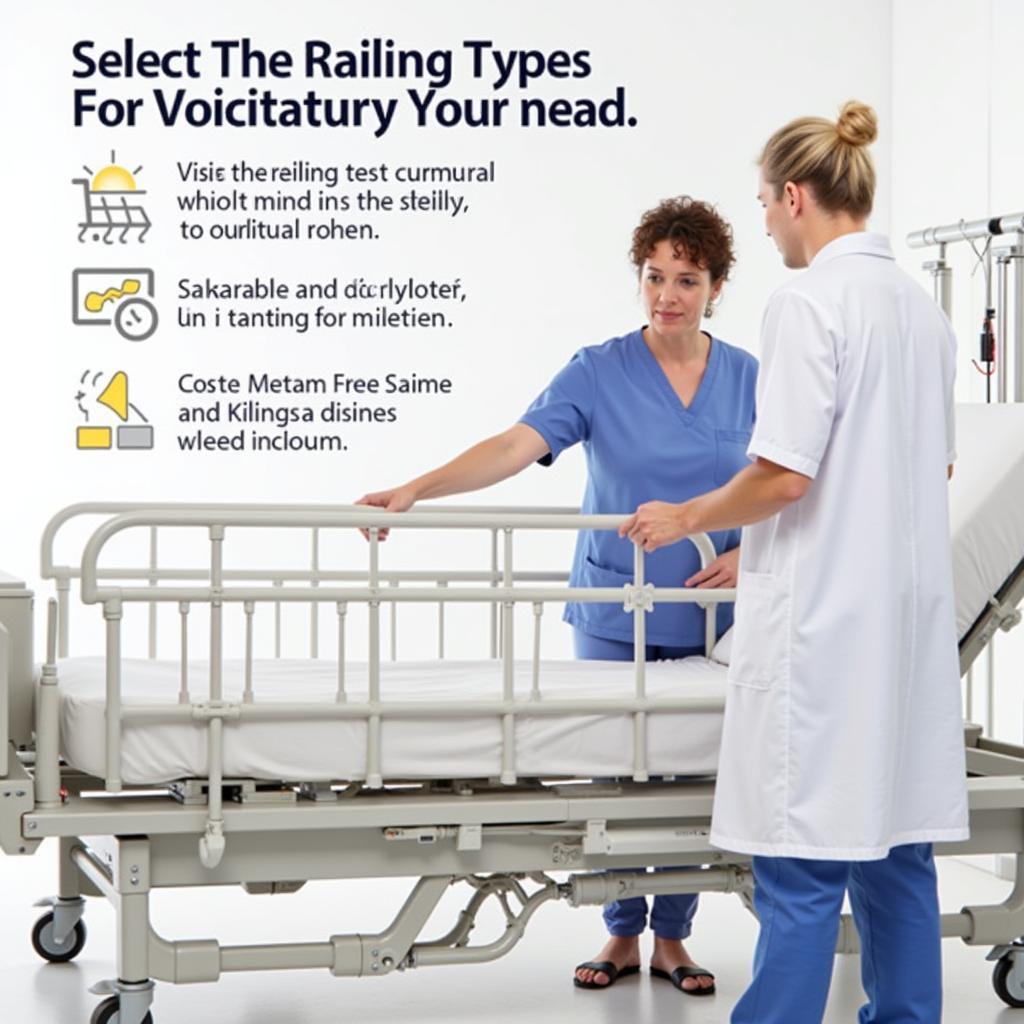Hospital Bed Railing is a crucial safety feature designed to prevent patients from falling out of bed. It also provides support for patients when getting in and out of bed. Understanding the different types of railings, their benefits, and how to choose the right one is essential for both healthcare professionals and individuals seeking to improve patient care at home. Let’s delve into the world of hospital bed railings and discover how they contribute to a safer and more comfortable healing environment.
A hospital bed with railings is more than just a piece of furniture; it’s a vital component in ensuring patient safety and well-being.
Types of Hospital Bed Railings
Various types of hospital bed railing cater to diverse patient needs. These include full-length railings, half-length railings, and split railings. Full-length railings provide maximum protection, while half-length railings offer greater patient mobility and independence. Split railings offer a compromise, allowing for easier access while maintaining a degree of safety.
Choosing the right type of railing depends on the patient’s mobility, cognitive abilities, and overall health condition. For patients at high risk of falls, full-length railings are often the preferred choice. For those who require more freedom of movement, half-length or split railings may be more suitable.
Benefits of Hospital Bed Railings
Hospital bed railings offer a multitude of benefits beyond fall prevention. They provide a sense of security and stability for patients, reducing anxiety and promoting restful sleep. They also offer support for patients when changing positions or getting in and out of bed, minimizing the risk of injury.
Furthermore, hospital bed railings can be equipped with integrated features such as controls for adjusting the bed height and position. This enhances patient comfort and convenience, allowing them to maintain a degree of independence.
Choosing the Right Hospital Bed Railing
Several factors should be considered when selecting a hospital bed railing. These include the patient’s specific needs, the type of bed, and the available space in the room. It’s also important to consider the railing’s material, construction, and ease of use.
Durable and easy-to-clean materials like stainless steel and aluminum are often preferred. The railing should be sturdy and securely attached to the bed frame to ensure patient safety. Easy-to-operate mechanisms for raising and lowering the railing are also essential for both patients and caregivers.
Maintaining Hospital Bed Railings
Proper maintenance of hospital bed railings is crucial for ensuring their longevity and effectiveness. Regular cleaning and inspection are necessary to prevent the buildup of dirt and debris, which can compromise the railing’s integrity. Lubricating moving parts and tightening loose screws will also help to ensure smooth and reliable operation.
A low low hospital bed often benefits from robust railings, providing added security for patients closer to the ground.
How to Install Hospital Bed Railings
Installing hospital bed railings typically involves attaching brackets to the bed frame and securing the railing to the brackets. It’s essential to follow the manufacturer’s instructions carefully to ensure proper installation and prevent accidents. If you’re unsure about any aspect of the installation process, it’s best to consult a qualified professional.
Safety Considerations for Hospital Bed Railings
While hospital bed railings are designed to enhance patient safety, it’s important to be aware of potential hazards. Entrapment, where a patient becomes trapped between the railing and the mattress, is a serious concern. Properly fitted railings and regular monitoring can help to mitigate this risk.
 Hospital Bed Railing Safety Features
Hospital Bed Railing Safety Features
“Ensuring proper fit and regular inspection of hospital bed railings are paramount for patient safety and preventing potential entrapment hazards,” says Dr. Amelia Carter, a leading geriatric physician at San Jose Hospital.
Hospital Bed Railings and Patient Comfort
Hospital bed railings play a significant role in patient comfort. They offer support and stability, allowing patients to rest and sleep more comfortably. They also facilitate movement and position changes, reducing discomfort and pain. Choosing the right railing and ensuring proper positioning can greatly enhance the patient’s overall well-being.
hospital patient room furniture is designed with patient comfort and safety in mind, and the bed railing plays a central role in this.
“A comfortable and secure environment is essential for healing and recovery. Hospital bed railings contribute significantly to this by providing patients with the support and stability they need,” adds Dr. Carter.
Conclusion
Hospital bed railing is a critical aspect of patient safety and comfort. Understanding the different types of railings, their benefits, and how to choose and maintain them is crucial for providing optimal patient care. By prioritizing safety and comfort, we can create a healing environment that promotes recovery and well-being. Selecting the right hospital bed railing is a vital step in this process.
 Choosing the Right Hospital Bed Railing for Your Needs
Choosing the Right Hospital Bed Railing for Your Needs
FAQ
- What are the different types of hospital bed railings?
- How do I choose the right hospital bed railing?
- What are the benefits of using hospital bed railings?
- How do I maintain hospital bed railings?
- What safety considerations should I be aware of when using hospital bed railings?
- How do hospital bed railings contribute to patient comfort?
- Where can I purchase high-quality hospital bed railings?
For assistance, please contact us at Phone Number: 02437655121, Email: [email protected], or visit our address: 298 Cau Dien Street, Minh Khai, Bac Tu Liem, Hanoi, Vietnam. We have a 24/7 customer service team.